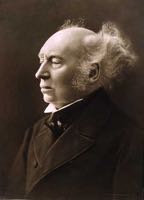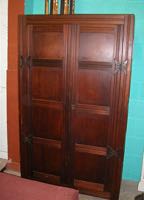
Kent Kingdon - decorative designer
Page updated 26th November 2016
Return to Exeter People Menu
 Of the two prominent
Kingdons in Exeter's history, Kent Kingdom is the one who left the
city a legacy which still informs and educates young and old alike
today. The
existence of the Royal Albert Memorial Museum is due, in some large part,
to the enthusiasm and foresight of Kent Kingdon. He was born in 1810,
to cousins Jane Kingdon and Thomas Medland Kingdon. "Iron
Sam" Kingdon of Garton and King was Kent's great uncle, and it seems that commerce was
in
the blood of the family. His father was established as a paper
stainer and upholsterer at 180 Fore Street. Paper staining was a method
of manufacturing wallpaper.
Of the two prominent
Kingdons in Exeter's history, Kent Kingdom is the one who left the
city a legacy which still informs and educates young and old alike
today. The
existence of the Royal Albert Memorial Museum is due, in some large part,
to the enthusiasm and foresight of Kent Kingdon. He was born in 1810,
to cousins Jane Kingdon and Thomas Medland Kingdon. "Iron
Sam" Kingdon of Garton and King was Kent's great uncle, and it seems that commerce was
in
the blood of the family. His father was established as a paper
stainer and upholsterer at 180 Fore Street. Paper staining was a method
of manufacturing wallpaper.
Around about 1828, after the birth of their youngest child, George Canning, Thomas Kingdon purchased Bowcliffe Cottage and Bowcliffe Field just above Red Cow village and built Taddiford House.
When Thomas Kingdon died in 1832, his business passed to his wife and his will stipulated that Kent, as the eldest surviving son would enter the business, alongside his mother, when he attained the age of twenty-one. His mother moved back to Fore Street to be closer to the business and Kent stayed living in Taddiford with his sister Jane.
Kent Kingdon developed a reputation for having a refined taste, and Taddiford House was an example of his approach to decoration and design, often exhibiting his favourite, if somewhat sombre, combination of ebony and French grey. He expressed his ideas on design in the house, on which he spent considerable time and money to suit his own use. He added a tower (circa 1870), Tudor style chimneys and Victorian windows, which along with pierced barge boards, wrought iron balconies and a large conservatory, which resulted in an eccentric combination of style. This was a long way from the heavy and often excessive, romantically ornate, Victorian style that was then in vogue.
His forthright views on culture and the arts, proved him unpopular in some quarters. He was interested in improving the moral and cultural life of the city, especially of the working class. He had little time for traders who tried hard to hide their humble origins, but he could be generous to a friend in need. He supported the arts in Exeter, and was an early patron of the painter William Widgery, father of F J Widgery. His collection of Widgery's went to the RAMM on his death.
Throughout his life, Kingdon was a major philanthropist and patron for good courses. In 1856 he agreed to supply furniture at cost price to the Devon Reformatory Institution and Refuge for Discharged Prisoners. June 1858, and he offered a £5 prize for an original conventional design in ornament at the Exeter School of Art. He was involved in the the Exeter Science School and was a benefactor for the RSPCA. The West of England Bank collapsed in debt in 1879 and Kingdon was involved in the fund to help impoverished shareholders, pledging £25.
Kingdon was an innovative man, and he had a patent granted in 1842, for embossing patterns onto silk, cotton and felted fabrics. His mother, as head of the household, is listed in the 1851 census as a paper-stainer, cabinet maker and upholsterer employing 16 men, 25 women and three boys. The family business had a workshop below the Iron bridge, and in October 1865, a serious fire resulted in the loss of £2,000 worth of tools.
Apart from upholstery and interior design, it was for his cabinet making that Kent Kingdon is most remembered, and yet surprisingly, the Royal Albert Memorial Museum does not have a single example of his work.
The Royal Albert Memorial Museum
And it is the Royal Albert Memorial Museum that is perhaps, according to some sources, Kingdons greatest legacy to the city of Exeter. The story is told of how Kingdon fell into conversation with Mr Winslow Jones, an Exeter solicitor, after a chance meeting in a hotel in Plymouth. The two men closely agreed on the lack of a centre for culture and the arts in Exeter and resolved to pay £100 each to further the establishing of such an institution. The idea was supported by the influential Dr Scott and Mr Kendal. This version of events differs from the accepted conception of the RAMM, in that Sir Stafford Northcote proposed the museum to commemorate Prince Albert. Whatever the truth, Kingdon was an enthusiastic supporter, attending many committee meetings and donating works of art to help establish the collection.
A fund was launched for a new museum in 1861 and a plot of land in Queen Street was donated by Richard Somers Gard MP. An immediate start was made on collecting exhibits for the new museum, which were temporarily stored in Colleton Crescent. Local gentlemen and businessmen donated money at different stages of the project and in 1865, Kingdon subscribed £10 to the new institution on the laying of the foundation stone, one of many donations over the years.
After a competition that attracted 24 entries, the architect of St Luke's College, John Haywood was engaged and the foundation stone for the Gothic design in Pocombe stone was laid in 1865. The North Wing was complete in 1868 and the South Wing in 1869.
The Kent Kingdon Trust
However, it was after the death of Kingdon on 2 April 1889, and his bequest to the museum that firmly cemented his place in the institution's history. His will stipulated that his collection of art and furniture go to the museum, and Taddyforde (his spelling) House sold with the proceeds to go to the Kent Kingdon Trust, after the death of his sister, Jane. He was also an investor in the Bristol and West Railway Co, the shares of which went towards the museum.
The trustees were to meet annually, on his birthday, and the interest from the trust be used to purchase books on ornamental and decorative arts and architecture. They were to purchase "no theological works or works of fiction of any sort or kind." Every third year they were to purchase "a good work of art in metal, wood, china or stone, or a good modern painting". His will was very thorough, even stipulating the material and size of the plaques that would mark his donations to the museum. Some of the clauses were rather onerous and were quietly dropped such as his requierement that the trustees should only be "gentlemen" and that every seven years the interior of the Museum be decorated in "grey and black but no gilding as I consider that exhibition rooms should be kept in very quiet good taste". Further information for new donations to the Kent Kingdon Trust from the museum.
The value of the trust reduced over time, due to inflation, and by the 1970s it was dormant. In 1994 it was revived, and although the interest is now diminished, the recent West of the Exe project has benefited from the Kent Kingdon Trust. The trustees in 2004 were Miss C. Jane Baker, Mr Peter Thursby, Dr Jonathan Barry, Dr Michael Pidgley, and chairman, Mr Ian Maxted.
These are some of the RAMM exhibits purchased by the trust over the years:
Stanhope Forbes (1857-1948) "22nd January
1901" (the announcement of the death of Queen Victoria)
Sir Herbert E.P.Hughes-Stanton
(1870-1937) "Cader Idris" (1918)
Lucy
Kemp Welch (1869-1958) "In sight: Lord Dundonald's last dash on
Ladysmith" (1901)
James
Northcote (1746-1831) "Portrait of the artist"
John Gendall.
"Exeter Cathedral
monumentarium" (Manuscript, 1835)
Wilfred Drake. Cartoon history of
Devon (1906).
John Dyer.
The
fleece: a poem (1757)
Ten silver pennies by Exeter moneyers
c991-1086.
Sculptures by Peter Thursby
Watercolour
by Francis
Towne
Portrait of Thomas Medland Kingdon, father of Kent Kingdon
Interestingly, the portrait of Thomas Medland Kingdon was originally left to the museum in the will. However, it was loaned to George Canning, Kent's brother and disappeared into the family, until it came up for sale and the museum purchased it back.
Taddiford House still stands, a Gothic-Victorian monument to a man who wished to spread 'good taste' to the masses, and left a legacy in the Royal Albert Memorial Museum that is still enjoyed today.
Source: The Kingdon Family - a Second Look by A S Kingdon, Kent Kingdons will, research undertaken by Iris Sutton and the Devon Local Studies website.
│ Top of Page │



